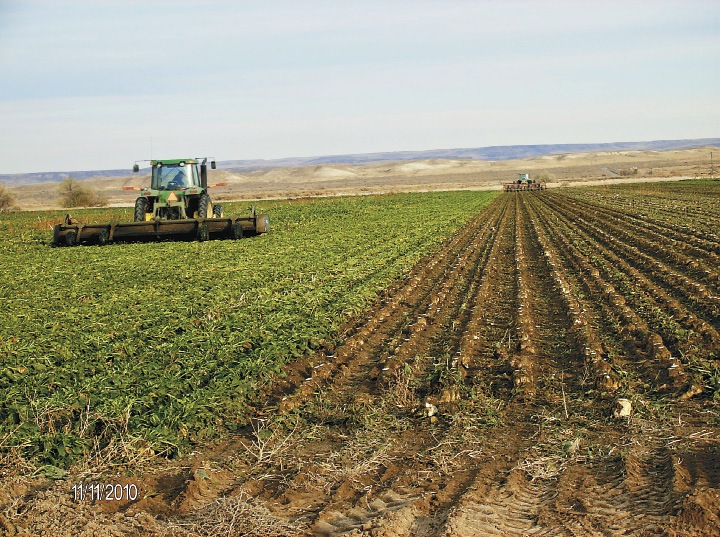 Sugarbeet production has adopted several new practices to improve yield and quality.
Sugarbeet production has adopted several new practices to improve yield and quality.
In the 1970s foliar feeding was introduced, which has allowed in-season adjustment for plant nutrient needs with the use of tissue testing. Although growers have adopted new efficiency practices and use revised fertilizer guides, adequate stand establishment is critical to maximizing sugarbeet yield. A large obstacle to stand establishment is overcoming soil crusting, which is essential to prevent many seedlings from dying or having delayed emergence. Growers using a good quality soil conditioner, such as Penatron, have seen greatly reduced crusting and many other soil and plant benefits.
Soil conditioning began with the Native Americans using fish to fertilize and improve the soil environment for crop growth. The Pilgrims were introduced to this practice, which assisted in the settlement of America.
In the 1980s, humic acid was introduced as a means to improve the soil environment. Many soils have problems with alkalinity, compaction, low organic matter, crusting and poor water infiltration.
Dr. Mir Seyedbadheri, University of Idaho extension educator in Elmore County, Idaho, is an internationally recognized pioneer in humic acid research. In the 1990s, he reported benefits of using humic acid on beets, potatoes and alfalfa hay. These benefits included increasing the efficiency of fertilizer and water use.
Several growers apply humic acid along with other soil conditioners like Penatron Soil Conditioner from Maz-Zee S. A. International, which was introduced in Idaho in 1993. Penatron, with 30 interactive components, has proven to work synergistically with humic acid to further improve the soil environment leading to production and quality increases.
Healthy crops that produce excellent yields and high quality come from soils where there is optimum oxygen, water and nutrients. Soil productivity ultimately relies on the quantity and quality of a wide range of microorganisms and fungal mycorrhizae.
These nutrients and fungi are limited in a low oxygen environment with a poor soil structure. Root cap cells stop dividing when oxygen is lacking. Mucilage is a thick slimy substance produced by microorganisms that glues soil particles together, creating larger soil aggregates, thereby creating improved soil structure. This slime aids in water and nutrient uptake by the roots and provides more oxygen for better plant growth. Plant roots secrete substances that are beneficial to mycorrhizal fungi, thereby forming a symbiotic relationship. Soil conditioning stimulates more mycorrhizal fungi as well as microorganisms. Improved oxygen levels in the root zone also decrease the presence of diseases that largely reproduce in an anaerobic environment.
Another benefit of using soil conditioners is improved water infiltration. Chemical or natural desert plant extract wetting agents lower the surface tension of water (makes water wetter), which can allow faster water infiltration. This helps because the water then filters into the soil profile easier, which decreases runoff and erosion. Improved water infiltration equals higher water use efficiency, which conserves our precious water resources and reduces pumping expense.
Some soil conditioners have growth substances that are beneficial to plants. This group of substances that include cytokinins, auxins and gibberellins give plant responses with low concentration of these materials. Norwegian sea kelp is one source that increases root growth by stimulating cell division. It also increases seed germination, lateral bud growth and chloroplast development. Some soil conditioners also contain small amounts of essential plant nutrients.
One key observed visual effect of using a good quality soil conditioner is a decrease in hot weather stress. Wilting is reduced on hot summer afternoons that occur in many beet growing regions. Penatron-treated beets remain turgid and thus are growing while untreated beets wilt and stop growing for several hours, resulting in reduced tonnage. Also, fewer clods and dirt at harvest have been observed, resulting in reduced tare and thus decreased hauling expense.
Two tests at Kimberly, Idaho, using Penatron Soil Conditioner resulted in reduced crusting. With clay loam soils, Penatron, applied over the row, gave improved final stand counts listed in the chart shown above.
Treated soils showed a significant reduction of crusting, which gave an increased stand count when compared with the untreated check. Production losses occurred with less-than optimum stand counts.
Sugarbeet yield increases using Penatron have ranged from 1.5 to 4 tons per acre. Penatron has also increased the harvested sugar percentage. Sugar increases of 0.46 percent to 1.18 percent over the untreated check have been measured. The bottom line is that sugarbeet growers have not only seen increases in yield and quality of their beet crops, but have also been good stewards of the land by using soil conditioning that directly affects the health of the soil. This creates an improved environment for rotation crops.
Our research data continues to show that adding a good quality soil conditioner creates better soil physical properties, improved plant nutrition, less weather stress, better water management, less erosion, reduced tare and harvest costs. Soil conditioners have assisted growers across the nation in producing higher yielding and better quality crops.